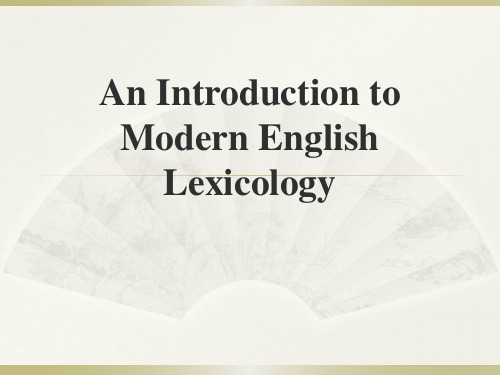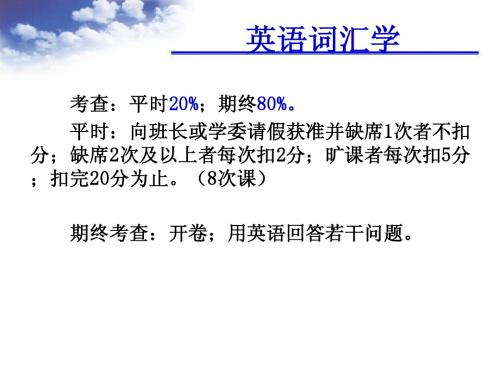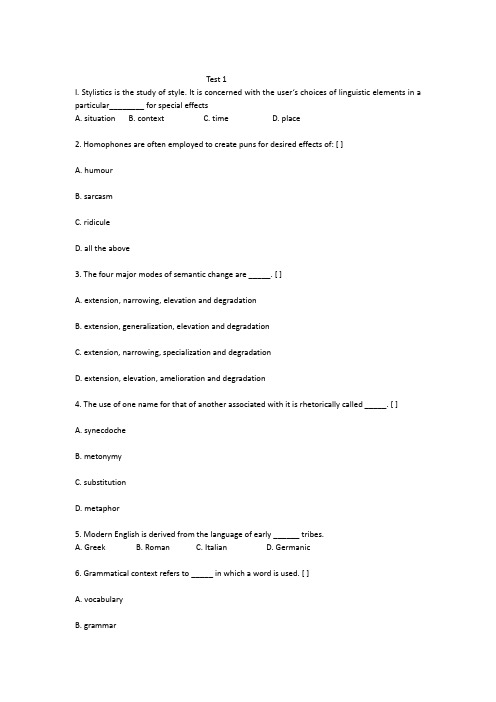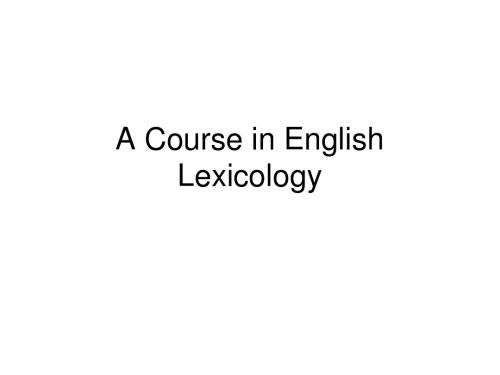词汇学1
大学词汇学第一章

2 weeks 1 week 1 weeks 2 weeks 1 weeks 1 weeks 1 week 1 week 1 week 1 week 1 week 1 week 1 week 1 week
考Hale Waihona Puke 形式1. 平时成绩50%(出勤、作业)。 2. 提交论文50%(3000—8000字)。
Introduction
1476年,Sir William Caxton发明印刷机。 早期现代英语(Early Modern English)逐渐形成。 文艺复兴(The Renaissance, 14-17世纪) 代表人物:达.芬奇,米开朗基罗等 英国剧作家莎士比亚(William Shakespeare,15641616)
Danish Icelandic Faroese Norwegian Swedish
Gothic*
German Dutch Flemish Frisian Afrikaans Yiddish
Old English(Anglo-Saxon):(AD400-1100) ---449 First landing of the Germanic warriors in Britain ---1066 Norman Conquest in Britain Middle English:(1100-1500) ---1476 Introduction of the Printing Press by Sir Willian Caxton ---1492 Discovery of the New World Early Modern English:(1500-1800) --- 1755 Dictionary of the English language by Samuel Johnson ---1776 American Revolution Modern English:(1800-present) ----20th C World wars, scientific breakthrough Contemporary English:(present and onwards)
英语词汇学(1)

英语词汇学
英语词汇学发展历史与现状: 20世纪80年代中期以后,西方语言学家开始 承认词汇学在现代语言学中的合法地位。我国于 20世纪80年代中期开始出现英语词汇学专著。20 世纪末至21世纪初,英语词汇学作为一门独立学 科、实用学科和交叉学科的地位得以巩固。
英语词汇学
Nature and domain of English lexicology:
英语词汇学
They are small in number but they form the mainstream of the basic word stock and stand at the core of the language. Therefore, native words have the same characteristics as those of the basic word stock. Apart from these, in contrast to borrowed words ,native words have two other features.
英语词汇学
专家: 1、陆国强:1934年生,复旦大学首席教授、外 文系英语语言文学博士生导师。出版专著:《现代 英语构词》、《现代英语联想与搭配》、《现代英 语词汇学》(新版)、《英汉和汉英语义结构对比 》。 2、汪榕培:1942年出生,1985年6月到2001年9 月担任大连外国语学院院长。现任大连大学特聘教 授,兼任苏州大学、大连理工大学等校博士生导师 。 1983年出版的《实用英语词汇学》是我国在这 一学术领域中的第一部专著,后来出版的《英语词
英语词汇学
Methods of study : 1.synchronic approach From a synchronic point of view,words can be studied at point in time,disregarding whatever changes might be taking place. 2.diachronic approach From a diachronic perspective,words can be considered historically and be looked into: the origins and changes in form and meaning.
词汇学(第一章)-PPT课件

.
14
3. Native words and borrowed words 本族语词和外来语词
Native words / Angle-Saxon words
Words of Anglo-Saxon origin are native
words. They form the great majority of the
.
13
Another important characteristic is that function words belong to a relatively small and permanent set of words, in comparison to content words. The total number of functional words is about 154. They are stable; they do not come and go with changing fashions and ideas.
basic word stock of the English language.
The basic word stock is the foundation of the
vocabulary accumulated over a number of
epochs. Most native words in modern
.
6
What causes the differences between sound and form?
➢ 1) More morphemes than letters, ➢ 2) Stabilization of spelling, ➢ 3) Deliberate change of spelling by
现代汉语词汇学1

现代汉语词汇学1一、词汇学:词汇学是以词汇和各种词汇成分的性质、构成、发展以及词语解释和运用的种种规律为主要研究对象的科学。
它包括了语源学、辞典学的内容和语义学的大部分内容。
古印度、古汉语的词汇研究:前者巴尼尼的《八章书》,后者汉代《尔雅》。
西方古希腊起就重词法。
索绪尔开启了现代语言学,但重结构形式的研究。
20世纪50年代以前美国描写语言学派等将“词汇”作为“实体”,加以排斥,“发现程序”中找不到“词汇”的影子。
50年代发轫的乔姆斯基转换生成语言学虽不排斥语义,但其语义分析是为语法分析服务的。
70年代初,欧美开始真正关注词汇研究,80年代以来词汇学成果频出。
二.词汇学的类别1.普通词汇学和个别词汇学普通词汇学是研究语言中的词汇的一般规律的词汇学子学科。
如张永言的《词汇学简论》:词的定义等,词的意义,词的词汇类别:语义类别、地域方言词语、社会方言词语、新词和旧词、基本词汇问题、外来词、口语词汇和书面语词汇、表情词汇(褒贬词语)、同义词、反义词、同音词、熟语。
个别词汇学是研究某种具体语言的词汇的独特规律的词汇学子学科。
如陆国强的《现代英语词汇学》。
2.词汇的历时研究和共时研究历时研究:历史比较词汇学和历史词汇学。
两者都是一种纵向的研究,研究词汇发展规律。
不同的是:前者研究亲属语言词汇间、不同方言词汇间的词语的同源关系及不同的发展轨迹。
后者研究具体语言词汇的发展演变规律,共时研究:也叫描写词汇学。
是一种横向研究,横断面式的研究。
也有人这样来分类:根据研究对象和方法的不同,词汇学可以分为普通词汇学、具体词汇学、静态词汇学和历史词汇学等。
(1)普通词汇学研究各种语言词汇的共同现象和规律;(2)具体词汇学研究某一具体语言或方言的词汇现象和规律;(3)静态词汇学研究某一时期的词汇现象和规律;(4)历史词汇学研究词汇发展演变的现象和规律。
现代汉语词汇学属于具体词汇学和静态词汇学。
三.现代汉语词汇学的研究对象和任务(一)研究对象普通话词汇为研究对象。
英语词汇学(一) 期末考试试题及参考答案

15.Some words in the basic word stock are said to be stable because they _____. [ ]
A. are complex words.
Test 1
I.Stylistics is the study of style. It is concerned with the user‘s choices of linguistic elements in a particular________ for special effects
A. situation B. context C. time D. place
B. are technical words
C. refer to the commonest things in life.
D. denote the most important concepts.
II. Complete the following statements with proper words or expressions according to the course book(10%)
B. Danish origin
C. Latin origin
D. Greek origin
14. Semantics is the study of meaning of different _________ levels: lexis, syntax, utterance, discourse, etc.
D. extension, elevation, amelioration and degradation
4. The use of one name for that of another associated with it is rhetorically called _____. [ ]
词汇学第一讲

1.3 Sound and Form
• It is generally agreed that the written form of a natural language is the orthographical(拼法) record of the oral form. Naturally the written form should agree with the oral form. In other words, the sound should be consistent with the form. • Question: Do you think such viewpoint lies in our real language world?
• To sum up, the definition of a word will cover the following points: • (1)a minimal free form of a language • (2)a sound unity • (3) a unit of meaning • (4) a form that can function alone in a sentence. • Then can you give a definition according to the above points?
• Example, some short vertical strokes such as “i, u, v, m, w, n” looked all alike, consequently, their handwriting caused misunderstanding, to solve the problem in part, they changed the letter “u” to “ o ”when it came before “m, n, v.”(we have no “uv”, immoral, impolite, illegal, irregular)
英语词汇学学习资料1

1.外来词分为四类:1 Denizens ,cup from cuppa , port form portus 2) Aliens garage , décor 3) Translation –loans e.g. long time no see 4) Semantic- loans.e.g. dream.2.Motivation 分类:onomatopoeic motivation, morphological motivation, semantic motivation, etymological motivation. Types of meaning: grammatical ~ & lexical ~; conceptual ~& associative ~(connotative~, stylistic~, affective ~, collocative ~,)多义关系及两种研究方法:Polysemy is a common feature peculiar to all natural language that one word has two or more senses or meanings. Diachronic approach is an approach to polysemy which studies how a word derived its different meanings from its primary meaning in the course of time.3.Synchronic approach is an approach to polysemy which studies the coexistence of various meanings of the same word in a certain historical period of time.4.Primary meaning is the only meaning that a word had when it was first created.5.Derived meanings are the meanings that a word gets from the primary meaning at different stages of its development in the course of time.6.同形同音异义关系Homonymy is one of the features of words that a word is different in meaning from another, but either identical both in sound and spelling or identical only in sound or spelling with the other Homonyms generally fall into three classes: perfect homonyms (same name); homographs (same spelling) and homophones (some sound). Perfect homonyms are those words identical both in sound and spelling, but different in meaning, e.g. bear /bea/ (n) a large heavy animal; bear /bea/ (v) to put up with. Homographs are the words identical only in spelling but different in sound and meaning, e.g. saw / / (v) to scatter seeds; sow /sau/ (n) female adult pig. Homophones refer to the words identical only in sound but different in spelling and meaning, e.g. dear /dia/ (n) a loved person; deer /dia/ (n) a kind of animal.7.同形同音异义词与多义词的区别Perfect homonyms and polysemants are fully identical with regard to spelling and pronunciation. This creates the problem of differentiation. The fundamental difference between homonyms and polysemants lies in the fact that the former refers to different words which happen to share the same form and the latter is the one and same word which has several distinguishable meanings. One important criterion is to see their etymology, i.e. homonyms are from different sources whereas a polysemant is from the same source which has acquired different meanings in the course of development. The second principal consideration is semantic relatedness. The various meanings of a polysemant are correlated and connected to one central meaning to a greater or lesser degree, e. g. neck (See 6.1 Polysemy) . On the other hand, meanings of different homonyms have nothing to do with one another. In dictionaries, a polysemant has its meanings all listed under one headword whereas homonyms are listed as separate entries.8.同义关系Synonyms are words which share the same or nearly the same meaning with each other but different in sound and spelling. There are absolute synonyms and relative synonyms which result from borrowing, dialects and regional English, figurative and euphemistic use of words, coincidence with idiomatic expressions. There exists the difference between or among synonyms in terms of their denotation, connotation or application. Absolute synonyms or complete synonyms are words which are identical in meaning in all its aspects. Relative synonyms or near-synonyms are similar or nearly the same in denotation, but embrace different shades of meaning or different degrees of a given quality.9.Sources of Synonyms 1) Borrowing 2)Dialects and regional English 3) Figurative and euphemistic use of words 4) Coincidence with idiomatic expressions10.如何区分同义词?1Difference in denotation2 Difference in connotation 3 Difference in application11.What are the characteristics of antonyms?12.1) Antonyms are classified on the basis of semantic opposition 2) A word which has more than one meaning can have more than one antonym. 3) Antonyms differ in semantic inclusion. 4) Contrary terms are gradable antonyms, differing in degree of intenisty, so each has its own corresponding opposite.13.上下义关系:Hyponymy deals with the relationship of semantic inclusion. That is, the meaning of a more specific word is included in that of another more general word. Superordinates refer to some general words; subordinates denote those more specific words. Hyponymy can be described in terms of tree-like graphs, with higher-order superordinates above the lower subordinates. But their status either as superordinate or subordinate is relative to other terms. For example, horse, dog, pig are subordinates in relation to animal, but superordinates of mare, hound and boar, Animal itself becomesa subordinate of creature. And creature in turn becomes14.词义变化的种类There are five types of meaning, changes: extension, narrowing, degradation, elevation, and transfer among which extension and narrowing are the most common. Changes in meaning can be accounted for from extra-linguistic factors (historical reason, class reason, and psychological reason) and intra-linguistic factors (shortening, the influx of borrowing, and analogy).15.词义的扩大Extension is a process by which a word with a specialized sense is generalized to cover a broader or less16.definite concept. Compare the following;词义的缩小Narrowing is a process by which a word of wider meaning acquires a specialized sense;词义的升华Elevation is a process by which a word moves from a derogatory or neutral sense to a neutral and/or appreciative sense;词义的降格Degradation is a process by which a word of reputation slides into a pejorative use,;词义的转移Transfer is a process by which a word denoting one thing changes to refer to a different but related thing. Paper serves as an example. This word formerly denoted an African plant papyrus, which was once used to make paper. In modern times, paper is made from rags, wood, straw and the like, but the product has retained the same name. There is associated transfer. There are other kinds of transfer, such as, concrete to abstract, abstract to concrete and transfer of sensation.17.语境的种类:非语言语境。
古代汉语词汇学

• 2.词义的扩大: • 词义的缩小的特点是古义的范围小于今义,古义一般包
括在今义之中。例如: • “色”表示脸色,现在是表示颜色、色彩。 • “河”表示黄河,现在是表示河流。 • “江”表示长江,现在是表示河流。 • “响”表示回声,现在是表示响声、声音。 • “裁”表示裁衣,现在是表示裁断、裁削。 • 3.词义的转移: • “走”表示跑,现在是表示行走。 • “脚”表示小腿,现在是表示足掌。 • “狱”表示案件、官司,现在是表示监狱。
• 例如 • 1)甲事物对乙事物具有标志作用,使甲代替乙,例如"齿"、"年"、"
兵"等。 • 2)借动作行为指代动作行为的主体或者客体。例如"将"、"薪"等。 • 3)借形状特点指代事物或者人,例如"刚"、"的"、"姝"等。 • 4)借方位处所指代事物或者人。例如"陵"、"室"、"宗"等。 • (3)相因:引申义和本义之间具有因果、条件等逻辑关系,通过推
• (2)辐射式引申:指由本义直接派生出来引申 义,它是以本义作为起点,向着不同的方向派 生出来几个直接引申义的词义引申脉络。
• 3、引申义的读音和书写形式:
• 词的本义和引申义,常常是用同一个字来表示的,读 音也绝大多数是一样的。但是有一些词,在词义引申 之后改变了读音,有的还另外造了字。例如:
• 二、古代汉语词汇复音化 • 1、同义词连用 • 2、经常连用的两个意义不同的单音词逐渐凝固 • 3、双音节单纯词的连用 • (1)叠音词 • (2)联绵词 • 1)双声 • 2)叠韵 • 3)非双声、叠韵 • 4、偏义复词的运用
- 1、下载文档前请自行甄别文档内容的完整性,平台不提供额外的编辑、内容补充、找答案等附加服务。
- 2、"仅部分预览"的文档,不可在线预览部分如存在完整性等问题,可反馈申请退款(可完整预览的文档不适用该条件!)。
- 3、如文档侵犯您的权益,请联系客服反馈,我们会尽快为您处理(人工客服工作时间:9:00-18:30)。
总,再加上个例子就可以拿满分了。
区分两个词的区别,主要还是指明其各自的定义。
第一章1. Word —— A word is a minimal free form of a language that has a given sound and meaning and syntactic function.2. There is no logical relationship between sound and meaning as the symbolic connection between them is arbitrary and conventional. E.g. ―woman‖ means ’Frau’ in German,’Femme’ in French and ’Funv ’in Chinese. On the other hand,the same sound /rait/ can mean right,rite and write,though denoting different things,yet have the same sound.3. The difference between sound and form result from 4 major factors.(At least 80%of the English words fit consistent spelling patterns)a). the internal reason is English alphabet does not have a separate letter to represent each sound in the language.b). Pronunciation has changed more rapidly than spellingc). Influence of the work of scribes/printing freezes the spelling of words in 1500d). Borrowing of foreign language4. Vocabulary —— Vocabulary is most commonly used to refer to the sum total of all the words of a language. It can also refer to all the words of a given dialect,a given book,a given subject and all the words possessed by an individual person as well as all the words current in a particular period of time in history.The general estimate of the present day English vocabulary is over 1 million words.5.Classification of Words—by use frequency,by notion,by origin1). Basic word stock – the foundation of the vocabulary.1. all national character (most important)– natural phenomenamost common things and phenomena of the human body and relationsworld around us names of plants and animalsaction,size,domain,statenumerals,pronouns,prep. ,conj.2. stability – they donate the commonest thing necessary to life,they are like to remain unchanged. Only relative,some are undergoing some changes. But the change is slow.e.g. arrow,bow,chariot,knight – pastelectricity,machine,car,plane —— now3. productivity – they are mostly root words or monosyllabic words,they can form new words with other roots and affixes.e.g. foot – football,footage,footpath,footer4. polysemy – often possess more than one meaning. Become polysemous.e.g. take to move or carry from one place to anotherto remove5. collocability – quite a number of set expressions,idiomatic usages,proverbial saying and otherse.g. heart – a change of heart, a heart of goldNon-basic vocabulary ——1. terminology – technical termsphotoscanning,hepatitis,indigestion,penicillin,algebra,trigonometry,calculus2. jargon – specialized vocabulary in certain professions.Bottom line,ballpark figures,bargaining chips,hold him back,hold him in,paranoid3. slang —— substandard words often used in informal occasionsdough and bread,grass and pot,beaver,smoky,bear,catch,holler,Roger,X-rays,Certain words are labeled slang because of their usage.4. argot – words used by sub-cultured groupscan-opener,dip,persuadercant,jargon ,argot are associated with,or most available to,specific groups of the population.5. dialectal words – only by speakers of the dialectbeauty,chook,cocky,station,auld,build,coo,hame,lough,bog6. archaisms – words no longer in common use or restricted in use. In older poems,legal document and religious writing or speech.7. neologism – newly created words with new meaning e.g. microelectronics,futurology,AIDS,internet,E-mailold meaning acquired new meaning e.g. mouse,monitor2). Content word (notional word)– denote clear notions.Functional word (empty word,form word)– do not have notions of their own,express the relation between notions,words and sentences.a. Content words constitute the main body of the English vocabulary are numerous.Functional words are in a small number.b. Content words are growing.Functional words remain stable.c. Functional words do far more work of expression than content words.3). Native words – are words brought to Britain in the 15 century by the German tribes. Ango-Saxon Words,50,000-60,000What is true of the basic word stock is also true of native world. More are1. neutral in style (not stylistical specific )2. 2.frequent in use (in academic fields and science French,Latin or Greek are used)(usage 70-90%)Borrowed words (loan words,borrowing)– words taken over from foreign language. 80%According to the degree of assimilation and manner of borrowing,we can bring the loan words under 4 classes.1.Denizens – words borrowed early and now are well assimilated into English language.e.g. port from portus(L)shift,change,shirt,porkcup from cuppa(L)2.Aliens – retained their original pronunciation and spellinge.g. décor(F)blitzkreeg(G)emir,intermez,rowtow,bazaar,rajar,status quo3.translation loans – formed from the existing material in the English language but modeled on the patterns taken from another language.1). Word translated according to the meaninge.g. mother tough from lingua maternal(L)black humor from humor noirlong time no see,surplus value,master piece2). Words translated according to the sounde.g. kulak from kyrak(Russ)lama from lama(Tib)ketchuptea4. Semantic loans – their meaning are borrowed from another languagee.g. stupid old dumpnew sassydream old joy and peacepioneer old explorer/person doing pioneering worknew a member of the young pioneerfresh old impertinent,sassy,cheeky。
